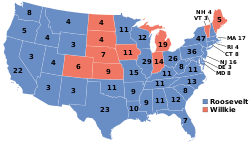| ||||||||||||||||||||||||||
| ||||||||||||||||||||||||||
 County Results
| ||||||||||||||||||||||||||
| ||||||||||||||||||||||||||
| Elections in Maine |
|---|
 |
The 1940 United States presidential election in Maine took place on November 5, 1940. All contemporary 48 states were part of the 1940 United States presidential election. State voters chose five electors to the Electoral College, which selected the president and vice president. Maine was won by Republican businessman Wendell Willkie of New York, who was running against incumbent Democratic President Franklin D. Roosevelt of New York. Willkie ran with Senator Charles L. McNary of Oregon while Roosevelt ran with Henry A. Wallace of Iowa.
Contents
Willkie won Maine by a narrow margin of 2.33%. This was a swing of 11.66% to Roosevelt during an election where he lost eight states and almost 700 counties that had supported him four years earlier, mostly because of Midwestern German-American opposition to increasing "tension" with Nazi Germany. [1] However, the Atlanticist tendencies of Yankee and French-Canadian Maine and support for aid to the United Kingdom and France in World War II led to substantial gains for Roosevelt in the state. [2] Maine was one of five states that swung more Democratic compared to 1936, alongside New Hampshire, Rhode Island, Vermont, and North Carolina. [3]
This was the first time that Kennebec County (home of Augusta, the state capital) had ever voted for a Democratic presidential candidate. [4]


